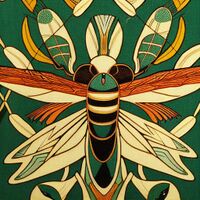Xaewoon

Xaewoon /zeɪ'wuːn, Yammoe: zaɪ'wuːn/ (Jabi for "the right path") is a nontheistic religion based on the Sacred Game of Roads. It originated in Tarnaria and has been exported into the Central Continent several times throughout history.
It postulates that humans and animals are on a path to Mamkoon (Jabi for "homeland"), with Eternal Companion being a strong focus of the theology.
Xaewoon has two main branches known as green stron and blue stron. Unlike other religions on the Continent, Xaewoon does not elevate humans over other animals in that regard, and all living creatures are considered to be equally bound by the theology. It also does not discriminate against ethos, nationality or language, although most believers who practice Xaewoon tend to speak Bukk and live in Tarnaria.
Xaewoon canon is oral and offers complex and fluid theology that has shaped the history of Tarnaria. It has strong links to Eater, but has also developed a relatively separate line of religious thought, mostly tied to the Dawn and the life of explorers in the eastern part of the Continent. Xaewoon depicts itself as a guide for mortals, as opposed to the Eon of Eater, which it views as a guide for gods. One of the most popular ties-in to Eater is the Stron Hoorhae (Song of Light) of the Oaleed. It depicts the hill of Mantar as the home of demigods, sent to guide and save mortals from Eater's minions.
It is one of four major religions on the Continent, along with Rahkahnja, Davinia and Foft, the latter being an offshoot of Xaewoon which has developed into a separate religion over time.
History
Xaewoon dates back to the Dawn and finds its origins in Loodori, a southern tarnarian country, where the religion is known under the name of Kajoon Tarkai. The third wave of the Dawn brought travelers through Gantolia and Yammoe into Tarnaria, frequently making their way into Loodori and only after that setting off for a trek to the north. This is where exposure to Kajoon is believed to have happened for many of the travelers of the third wave.
Xaewoon has developed as a way to add purpose to the difficult exploration of the new and hostile world. The Sacred Game of Roads might have been a vehicle to understand and explain successes and failures along the way. The clear visibility of Eternal Companion in the night sky explains the influence of the star on the theology of Xaewoon, a bright light that shines on the paths of the pioneers of Tarnaria.
Xaewoon theology shares a superficial resemblance to Kajoon and uses a lot of the same concepts, as well as traditionally being practiced mostly in Jabi. In fact, the majority of Xaewoon believers don't speak Jabi and instead know it in a very limited fashion as the language of their religion. In spite of this, the theologies of the two religions are completely incompatible.
Xaewoon also does not seem to have much in common with Rahkahnja. Xaewoon and Rahkahnja have retained some influence of Davinia, but mysteriously no influence at all from Lolion, which was a major religion in the Western Dantrian civilization. Some researchers suggest that migrants of the Dawn might have been followers of minor religions and that this had contributed to their exodus.
Original Xaewoon canon was what is today called Xaewoon Blue. The rule of Five Kings and the resulting philosophy of Mōroh had splintered religion into Blue and Green. The nomenclature was introduced by Xaewoon Blue followers, with the goal of differentiating themselves from the heretics. Xaewoon Green followers initially rejected the label, proclaiming that their religion is the only true interpretation, but eventually it was adopted and the symbol of Xaewoon Green became Eternal Companion with the Great Hornet on green background. Elements of green in clothing became popularized by the Kareden.
Beliefs
Believers view life as a journey to Mamkoon, the homeland of all. Life provides many paths, and the goal of the traveler is to find the right path, the Xaewoon. Eternal Companion is the protector of the faithful and the guide to Mamkoon.
Unlike other religions on the Continent, Xaewoon does not elevate humans over other animals in that regard, and all living creatures are considered to be equally bound by the theology.
There are two major interpretations, the green stron and the blue stron (Jabi for "song"). They are frequently denoted as Xaewoon Green and Xaewoon Blue. They differ in how they view Mamkoon, which, in turn, created quite differing and ultimately incompatible theologies: the green stron postulates that Mamkoon is an actual physical location that one must reach within one's lifetime; the blue stron regards Mamkoon as a metaphor.
Xaewoon canon is passed down from generation to generation in oral form, through lores (storytelling with songs) and through playing the Sacred Game of Roads. The oral tradition is very strong and is noted for its high accuracy. There is no formal prohibition of the written word, but books are rare. Green stron followers tend to be less accepting of the written word.
Still, this makes the theology relatively fluid and introduces a great deal of variation and complexity. So much so, that some regional versions are idiosyncratic to the point where it is not trivial to understand the link between local theology and the Xaewoon canon.
An individual must begin their journey, their Iyando (Jabi for "wandering") when they turn 12 years of age. It involves a year-long journey away from one's home in the company of one or several elders. Such elders would be part of the Ienana (Jabi for "devoted"), effectively monks who have dedicated their lives to helping others with their faith. The elder would also use the time to test the seriousness and the devotion of the neophyte.
Xaewoon Blue

Blue stron regards Mamkoon as a metaphor. There is no physical location that is the Mamkoon. Instead, Mamkoon is something akin to non-existing, which is understood to be the perfect harmony. Mamkoon can and should be found during one's lifetime. Failure to do so means that the person would be re-born and would need to go through an even more difficult life. The cycle would repeat until Mamkoon is found or until Eater devours the world.
Xaewoon Blue puts great emphasis on personal growth, and in that sense is very close to Xaewoon dark green.

Xaewoon Blue devotees also worship the skycat, Cangon, who is a friend of Eternal Companion, but an unintentional menace to creatures on earth. Like a kitten who drops a cup on the floor, Cangon is generally believed to be responsible for anything that appears random and capricious, such as the weather. Misfortunes, sickness and lack of luck mean that "Cangon is playful" (marmanee Cangon). The phrase is frequently added to the end of a sentence when it's intention is to complain about something benign, like bad weather. Appeasing Cangon, making him sleepy or distracted is the purpose of the many Xaewoon Blue rituals.
The acceptance of Cangon is a significant source of disagreement between the blue and green strons. Essentially, Cangon is viewed as an element that reduces one's agency. Gened's defiance of Cangon is in asserting a belief that one is a true owner of one's fate and the rejection of the idea that external factors might be instrumental in one's life to a significant extent.
Thus, contrary to popular belief, Xaewoon Green doesn't reject the existence of Cangon, but rather rejects its power over the lives of mortals.
Xaewoon Green
According to the green stron, Mamkoon is an actual physical location that one must reach within one's lifetime. The path is considered to be written in the skies therefore green stron followers study star patterns, and at times might be required to make complicated journeys, because their path on the sky turns out to be precarious on the terrain.
Within this stron there is a division into light green and dark green. Dark green believers consider Mamkoon to be personal and would search for a location that is specific for their personal religious journey, which makes the dark green interpretation very close to the blue stron, if not in form, then in spirit.
Light green adherents, on the other hand, believe that Mamkoon is a single physical location for everyone, a location that all true believers should travel to. There are many caveats, and simply knowing the location is not enough. One must instead be able to go on a mission and find one's own path to Mamkoon, which in many cases means that a person is actually not allowed to travel to the location believed to be the Mamkoon, let alone settle there, until their religious path is fulfilled.
Which physical location is the Mamkoon is a matter of active disagreement. The disagreement is largely non-violent and is positioned as part of what it means to practice Xaewoon.
One school of thought claims that Mamkoon's location is known to some Ienana, but cannot be revealed until one reaches a certain point in their path. Another approach is to consider Mamkoon's location to be a matter of the search of Xaewoon believers as a whole. This interpretation incurs stricter rules on believers, as a failure to follow one's path becomes everyone's problem.

Cangon, the skycat, is completely missing from Xaewoon Green canon, although its existence is not necessarily rejected. Instead, the light green interpretation introduces the Great Hornet. Initially simply a replacement for Cangon that would not interfere with the lives of the mortals, it eventually evolved into the helper of mortals, a prophet figure who will lead believers to the true Mamkoon. Sometimes, such a visionary is referred to as a "Kasanja", the “prophet of far away lands”. This theology fueled a number of nomadic kingdoms in Tarnaria, such as the Kareden and the Overpol Expanse. Numerous religious leaders claim one or the other location to be the homeland.
Throughout history light green has proven to be a more violent version of the faith. Unlike Xaewoon Blue, Xaewoon Green has a specific term for true believers, Trenonoh or Trenona, which means "people of the path". Light green devotees were the majority during the second revolution, but with the turn of the third revolution the dynamics began to change, and today dark green constitutes the majority, making the religion a bit more tolerant.
Foft
Main page: Foft
Xaewoon Blue has less interpretations than Xaewoon Green, but several have gained prominence over the course of history.
Foft is an alternative interpretation which focuses on the relationship between Eternal Companion and Cangon and teaches that Cangon's behavior is reflective of a person's deeds and morality. Foft has mostly found devotees outside of Tarnaria due to their prosecution by the Angry King. Hee became the First Ienana of Foft, leading the brief culture war against Mantar's version of the Oordar rule. However, his support of Foft established it as a major religion in Tref.
Relationship with Kajoon
Main page: Kajoon Tarkai
As Xaewoon originated in Loodori, Kajoon Tarkai superficially sounds very similar. It is, however, ultimately a very different worldview and is a very elitist worldview as opposed to a very egalitarian approach of Xaewoon.
Kajoon generally postulates that Loodori's native population are descendants of the people who were displaced to the Continent from Mamkoon, their true home. These people are called "kajoons" (the natives). The bloodlines are, thus, of paramount importance. Mamkoon is considered to be a specific location, but that can only be reached when the person is ready. Therefore, life is viewed as preparation for a voyage to Mamkoon.
Kajoon believers either regard Xaewoon as an unfortunate misinterpretation of their worldview or as an imposter religion that tries to coopt the claim of kajoons to Mamkoon. Some factions consider Xaewoon to be completely unconnected to Kajoon.
The attitude on the Xaewoon side is much more tolerant and Kajoon was regarded as a compatible belief system by many in central and northern Tarnaria, especially during the second revolution. It was even classified as Xaewoon White or Xaewoon Magnolia. Central tarnarians continued to borrow ideas from Kajoon, weave it into their own theology and then disseminate the updated theology to the north. The concept of Kasanja, for example, was an idea borrowed from Kajoon in the middle of the second revolution and brought into the mainstream by the Kareden. The concept of Trenona, completely absent from Xaewoon Blue, became an operating idea in Xaewoon Green and is borrowed directly from Kajoon's concept of kajoons.
Relationship with Eater
Main page: Eon of Eater
Among all the major religions on the Continent, Xaewoon probably has the weakest link to the myth of Eater.
Ienana
While both strons have a class of especially devoted believers, the Ienana (singular and plural forms are the same), Xaewoon Blue have a more decentralized and a more numerous Ienana. Ienana are also bound by a more strict code of conduct and are treated with reverence.
Green stron Ienana are more organized, more formalized and are frequently part of the government or aligned with the ruling family/class one way or another. While that gives green stron Ienana more formal power, throughout history a blue stron Ienana was more likely to emerge as a very powerful individual and a leader of whole peoples.
A notable historical exception was the rule of the Angry King in Mantar, who made Xaewoon Blue the official state religion and instigated laws against non-believers, foreigners and devotees of alternative Xaewoon Blue interpretations, specifically Foft. Nilma appointed many Ienana to formal government positions, although ultimately it created a sub-class of Ienana specific to Mantar. These Ienana retained their religious significance, but were considered as devotees of a much lesser degree than the traditional blue stron Ienana.
Foft is also an exception in that it has a hierarchy consisting of a First Ienana, a title usually given to the King of Kings or head of a ruling family, and Following Ienana, the number of which is defined by the amount of ruling family members that have a family of their own. Each Following Ienana is then considered to be First in their parish and would have Following Ienana based on the number of people in the congregation.
Canon
The practice of Xaewoon does not use written texts, instead placing great importance on the oral tradition of lores: a collection of strons (songs) that are being passed down from generation to generation. The songs are a mixture of myths, fables and early history of Tarnaria, frequently with religious undertones.
The strons are traditionally performed with a dalas, a single string instrument, and a tarati, a small flute. Dalas represents Eternal Companion and tarati represents either Cangon or the Great Hornet. Music pieces involve a duet between a dalas and a tarati, with the vocalist either singing or speaking the text.
First revolution performers used only dalas. The use of tarati is thought to have originated with the Oaleed, who have disseminated the tradition in the beginning of the second revolution throughout the Commonground. It then moved south along the Erna river. The use of dalas is less common in the south of Tarnaria. Traditional Ybuwyn music, for instance, involves a singer and the bowonn drum.
Singing of lores is viewed as both a past time and education. Children are expected to know most of the local lore by the time they turn 12. The tradition of singing strons was always prevalent in Tarnaria. Additionally, traditional performers called singers of lore are an important part of the culture and are the ones who professionally retain and disseminate strons.
Teaching the lore to one's offspring and learning strons from one's parents and famous performers is an important and cherished part of the Xaewoon religion.
List of lores
- Moon Book -
- The Great Lore - a tradition, closely connected to performers such as Osdol and Motys
- Swift Hen - a tradition launched by Morol, meant to compete with the Great Lore and rewrite history according to Mōroh principles
- Couth Flame
Formations
Xaewoon's dominance in Tarnaria, combined with a strategic tolerance towards other religions, has resulted in the so-called formations, semi-official denominations, comprised of various religions and Xaewoon. The most common ones are Xaewoon Lolion, Xaewoon Davinia and Xaewoon Rahkanja.